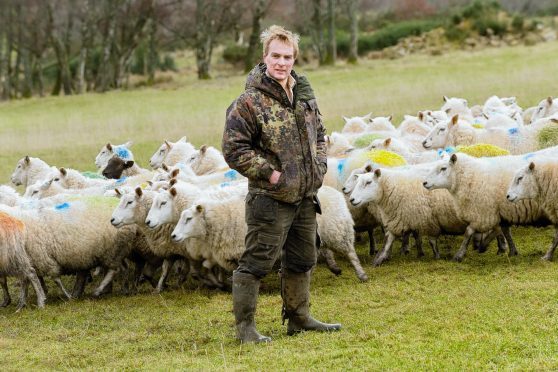Inverness farmer Euan Ferguson decided if he had to electronically identify (EID) his sheep flock, he would make the most of the information it provided.
He is now convinced that EID is the way forward to improve management and efficiency.
Mr Ferguson started recording 12 months ago and now has a whole year of data which has allowed him to start making informed decisions about breeding sheep and replacements.
He recently hosted a Quality Meat Scotland (QMS) workshop on his farm where the benefits of EID were highlighted to other farmers in the area and also talks about the benefits in a new QMS video on the subject, which has had more than 19,000 views on Facebook to date.
Mr Ferguson manages a 1,250 breeding ewe flock for Chris Swift whose South Clunes Farm at Kirkhill, Inverness runs to about 700 acres, with a further 700 acres rented.
About 300 acres is arable with the rest permanent and temporary grass supporting a herd of 60 spring-calving Luing cross cows and the Texel, Mule and Lleyn cross ewes.
Sheep farmer, consultant and Nuffield scholar Catherine Nakielny, who also features in the new video, said: “The farming sector can often benefit from looking at other industries for ideas on how to improve profitability. Measuring day-to-day performance is a common theme in many successful enterprises and farming is not any different.”
For Mr Ferguson, who admits he was initially apprehensive about how to use the technology associated with EID, the breakthrough point was when he found a quick and simple system of recording which did not involve spending hours at the sheep fank.
He invested about £2,700 in a new weigh crate and Trutest tag reader which downloads data in seconds onto an easy-to-read excel spreadsheet.
He has also recently spent about £200 on a hand-held reader, which he says is really useful for identifying ewes in pens at lambing and linking up her lambs.
Already, after just a year in use, Mr Ferguson has information on ewe efficiency which is allowing him to select replacement ewe lambs from the best performing mothers. He is also excited about the additional data he plans to collect over the next few years which will give him a clear picture of how each animal is performing in the flock.
Mr Ferguson believes that there are so many ways to use the information which can all help to improve flock efficiency.
He said: “The real benefit of EID is that it allows you to evaluate the business in so many ways. This year I plan to experiment with worming groups of lambs. Worm resistance is a real problem and if I can achieve consistent daily liveweight gains while cutting down on the amount of anthelmintics we use, there will be a real benefit to the business.”
Lambs are weight recorded every four to five weeks from birth which gives Mr Ferguson daily liveweight gain figures and has helped him to achieve more consistent finished weights within the required 20 to 21kg deadweight specification.
He supplies lamb to Highland Cook House, which produces ready meals, and he also supplies the lamb used on all Scottish Railway lines and the North/South sleeper train.
They require a constant supply of 40 lambs every two weeks throughout the year so Mr Ferguson has to plan his lambing and finishing to suit this market.
A February lambing of 140 Texel Mules crossed to the Suffolk allows him to supply new season lamb to the company from June, while the main flock, which starts lambing in April, supplies lamb and hogget the rest of the year.
He said: “At this time of year, we are weighing the hoggets every two weeks, drawing 40 off for sale and putting another 40 of the forward ones onto a two week finishing pellet ration. This way we get a good finish and consistent product all year round.”
Using the EID and weigh crate allows Mr Ferguson to analyse the performance of the lambs, with the best gaining up to 450g/day on pellets while grass-finished lambs in the summer can gain 300 to 350g/day.
Mr Ferguson has no hesitation at all in recommending EID and embracing all it has to offer, to other sheep farmers. He said: “Do not be put off by the technology or cost. It can be so, so easy to use and after the initial investment, there are no annual running costs.”










